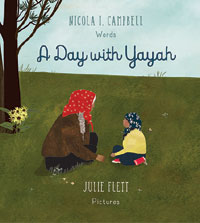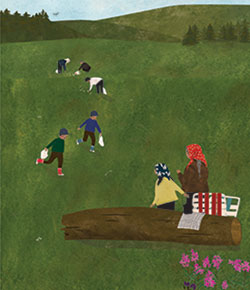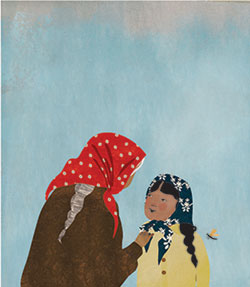| ________________
CM . . .
. Volume XXIV Number 15. . . .December 15, 2017

 |
A Day with Yayah.
Nicola I. Campbell. Pictures by Julie Flett.
Vancouver, BC: Tradewind Books, 2017.
32 pp., hardcover, $19.95.
ISBN 978-1-926890-09-8.
Grades 2-5 / Ages 7-10.
Review by Gregory Bryan.
*** /4
|
| |
|

excerpt:
“It is very important that all plants and mushrooms are carefully examined and identified before you eat them,” Yayah explained. “Some plants are very poisonous. Does anyone see a poisonous plant nearby?”
The scmémi’?t looked everywhere. They saw fragrant pine trees, wildflowers, and tall grass. All around them the birds were singing. Then they saw some low shrubs with shiny, dark-green pointy-tipped leaves.
“Poison ivy!” all three kids hollered at once.
In A Day with Yayah, an Indigenous family sets off into British Columbia’s Nicola Valley woods to collect wild herbs and mushrooms in the springtime. The grandmother—Yayah of the book title—takes the opportunity to teach her grandchildren about their language and about edible plants. Yayah and her family are Nle?képmx - a part of the Interior Salish peoples, referred to often as People of the Creeks.
 At the bottom of many of the pages, a word (or two or three words) appears in green font. These words appear in a glossary at the back of the book. The glossary also includes a pronunciation guide for the Nle?képmxcin words. Somewhat confusingly, those green words appearing at the bottom of a page do not always appear in the written narrative on that page. For example, at the bottom of the second page of written text, the three words c’ewéte?, tetúwn’, and scmémi’?t all appear. These words all first appear on the first page of written text, and only one of them appears in the main narrative on the second page. Two words are highlighted at the bottom of the third page of written text. Each of these words first appeared on page one, but only one of them appeared in the narrative on page three. As such, I was left confused as to why words were highlighted when they were. Although the glossary and pronunciation guide are invaluable, the need to turn to the back of the book while reading certainly interrupts the narrative. The words and pronunciation were so unfamiliar to me that even with the glossary and pronunciation guide, as a non-Nle?képmxcin speaker, I was still left confused.
At the bottom of many of the pages, a word (or two or three words) appears in green font. These words appear in a glossary at the back of the book. The glossary also includes a pronunciation guide for the Nle?képmxcin words. Somewhat confusingly, those green words appearing at the bottom of a page do not always appear in the written narrative on that page. For example, at the bottom of the second page of written text, the three words c’ewéte?, tetúwn’, and scmémi’?t all appear. These words all first appear on the first page of written text, and only one of them appears in the main narrative on the second page. Two words are highlighted at the bottom of the third page of written text. Each of these words first appeared on page one, but only one of them appeared in the narrative on page three. As such, I was left confused as to why words were highlighted when they were. Although the glossary and pronunciation guide are invaluable, the need to turn to the back of the book while reading certainly interrupts the narrative. The words and pronunciation were so unfamiliar to me that even with the glossary and pronunciation guide, as a non-Nle?képmxcin speaker, I was still left confused.
With all this said, however, I repeat that the glossary and pronunciation guide are invaluable. Tradewind Books is to be applauded for authentic language use. Books such as A Day with Yayah can help to preserve and spread Indigenous languages. As such, this is an important and valuable book.
 The creators, Nicola I. Campbell and Julie Flett, are both award-winners. Campbell is Interior Salish and Métis. Flett is Cree-Métis. Campbell’s written text conveys the existence of a tender, loving relationship between grandmother and grandchildren. Flett’s beautiful illustrations are boldly colour-filled and infused with the detail typical of her art.
The creators, Nicola I. Campbell and Julie Flett, are both award-winners. Campbell is Interior Salish and Métis. Flett is Cree-Métis. Campbell’s written text conveys the existence of a tender, loving relationship between grandmother and grandchildren. Flett’s beautiful illustrations are boldly colour-filled and infused with the detail typical of her art.
I believe this book may win awards. Yet, I do not see it having wide appeal. There is certainly a place for it in school libraries. In the hands of skilful teachers and loving adults, the book can serve a number of educational purposes. It is not, however, a book that children will want to read over and over again. In places, it is didactic—the explicit teaching overpowers the quality of the story—but A Day with Yayah is a worthwhile addition to the growing body of quality Indigenous Canadian children’s literature.
Recommended with Reservations.
Dr. Gregory Bryan is a member of the Faculty of Education at the University of Manitoba. He specialises in literature for children.

© CM Association
CC BY-NC-ND
Hosted by:
University of Manitoba
ISSN 1201-9364
|
This Creative Commons license allows you to download the review and share it with others as long as you credit the CM Association. You cannot change the review in any way or use it commercially.
Commercial use is available through a contract with the CM Association. This Creative Commons license allows publishers whose works are being reviewed to download and share said CM reviews provided you credit the CM Association. |
Next Review | Table of Contents for This Issue - December 15, 2017.
CM Home | Back Issues | Search | CM Archive | Profiles Archive
|

 At the bottom of many of the pages, a word (or two or three words) appears in green font. These words appear in a glossary at the back of the book. The glossary also includes a pronunciation guide for the Nle?képmxcin words. Somewhat confusingly, those green words appearing at the bottom of a page do not always appear in the written narrative on that page. For example, at the bottom of the second page of written text, the three words c’ewéte?, tetúwn’, and scmémi’?t all appear. These words all first appear on the first page of written text, and only one of them appears in the main narrative on the second page. Two words are highlighted at the bottom of the third page of written text. Each of these words first appeared on page one, but only one of them appeared in the narrative on page three. As such, I was left confused as to why words were highlighted when they were. Although the glossary and pronunciation guide are invaluable, the need to turn to the back of the book while reading certainly interrupts the narrative. The words and pronunciation were so unfamiliar to me that even with the glossary and pronunciation guide, as a non-Nle?képmxcin speaker, I was still left confused.
At the bottom of many of the pages, a word (or two or three words) appears in green font. These words appear in a glossary at the back of the book. The glossary also includes a pronunciation guide for the Nle?képmxcin words. Somewhat confusingly, those green words appearing at the bottom of a page do not always appear in the written narrative on that page. For example, at the bottom of the second page of written text, the three words c’ewéte?, tetúwn’, and scmémi’?t all appear. These words all first appear on the first page of written text, and only one of them appears in the main narrative on the second page. Two words are highlighted at the bottom of the third page of written text. Each of these words first appeared on page one, but only one of them appeared in the narrative on page three. As such, I was left confused as to why words were highlighted when they were. Although the glossary and pronunciation guide are invaluable, the need to turn to the back of the book while reading certainly interrupts the narrative. The words and pronunciation were so unfamiliar to me that even with the glossary and pronunciation guide, as a non-Nle?képmxcin speaker, I was still left confused.
 The creators, Nicola I. Campbell and Julie Flett, are both award-winners. Campbell is Interior Salish and Métis. Flett is Cree-Métis. Campbell’s written text conveys the existence of a tender, loving relationship between grandmother and grandchildren. Flett’s beautiful illustrations are boldly colour-filled and infused with the detail typical of her art.
The creators, Nicola I. Campbell and Julie Flett, are both award-winners. Campbell is Interior Salish and Métis. Flett is Cree-Métis. Campbell’s written text conveys the existence of a tender, loving relationship between grandmother and grandchildren. Flett’s beautiful illustrations are boldly colour-filled and infused with the detail typical of her art.